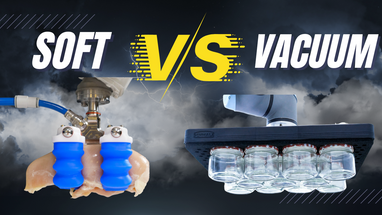Aug 6th 2025
Choosing Your Robot Gripper: Soft or Vacuum? (The Pros & Cons You NEED to Know!)
When you're automating a pick-and-place task or designing an end-of-arm tooling (EOAT) solution, one of the most important choices you'll make is which type of gripper to use. Two of the most common—and often confused—options are soft grippers and vacuum grippers.
Both have their strengths. Both have their weaknesses. And the best choice depends entirely on your application.
In this post, we’ll break down the pros and cons of soft and vacuum grippers so you can choose the right one for your robot, your product, and your productivity goals.
What Is a Soft Gripper?
Soft grippers are made from flexible materials like silicone or rubber. Their flexible fingers adapt to the shape of the object they grasp—much like a human hand.
They’re ideal for handling delicate, irregular, or deformable objects. Think baked goods, fruits, electronics, or oddly shaped components.
Pros of Soft Grippers:
-
Versatile Geometry Handling
Grips objects with unusual shapes or inconsistent sizes—without complex programming. -
Gentle on Fragile Items
Won’t bruise, crush, or scratch sensitive items like produce or packed food. -
No External Air Supply Needed (for electric models)
Some soft grippers are electric-powered and self-contained, simplifying integration. -
Safe for Collaborative Robots
Their soft material makes them ideal for cobots working near people.
Cons of Soft Grippers:
-
Limited Payload
May struggle with heavier items due to their flexible, less rigid design. -
Slower Cycle Times
Some applications see reduced speed vs. vacuum gripping. -
Durability Concerns
The soft material can wear out more quickly in harsh environments. -
Less Precise Placement
May not offer the same repeatability as rigid-finger or vacuum systems.
What Is a Vacuum Gripper?
Vacuum grippers use suction cups and negative pressure to lift objects. They're one of the most widely used EOAT types in packaging, palletizing, and electronics industries.
Vacuum grippers are often the go-to for flat, smooth, and sealed surfaces—like cardboard boxes, glass panels, or plastic containers.
Pros of Vacuum Grippers:
-
Fast, Reliable Pick-and-Place
Ideal for high-speed operations like packaging and palletizing. -
Handles Multiple Items Simultaneously
Some systems lift multiple objects at once, boosting throughput. -
Minimal Contact
No gripping force applied—just suction. Ideal for clean surfaces. -
Lightweight Design
Keeps payload low, maximizing robot speed and range.
Cons of Vacuum Grippers:
-
Needs Compressed Air
Requires a vacuum generator—adding cost, space, and maintenance. -
Can Struggle with Porous or Uneven Items
Paper bags, foam, mesh, or loose packaging may cause suction failures. -
Noise and Energy Use
Vacuum systems can be loud and consume significant air power. -
Dust Sensitivity
Particulate matter can reduce suction effectiveness and clog filters.
Which Should You Choose?
| Application Type | Recommended Gripper |
|---|---|
| Soft, irregular objects | Soft Gripper |
| Flat, sealed surfaces | Vacuum Gripper |
| Fragile, bruise-prone items | Soft Gripper |
| High-speed packaging | Vacuum Gripper |
| Cleanroom or low-maintenance | Electric Soft Gripper |
| Heavy lifting or large boxes | Vacuum Gripper (Multi-cup) |
Final Thoughts
There’s no one-size-fits-all answer when choosing between soft and vacuum grippers. The best gripper is the one that aligns with your product characteristics, speed requirements, robot type, and production goals.
Need help choosing the right EOAT for your application? As a trusted distributor of leading robotic grippers—from SMC, OnRobot, Schmalz, and more—we’re here to help you design the perfect solution.
Ready to upgrade your robot’s grip?
Contact us today for expert guidance and customized recommendations or browse available robot grippers on our website here.

